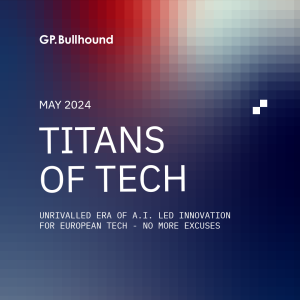Tech Thoughts Newsletter – 20 October 2023.

Market: A busy week for results across the market – not only tech but big US banks (mixed), industrials (mixed) and Powell out speaking and driving rates up further.
Portfolio: We added to our position in LAM Research on weakness around results (details below) this week.
This week’s big news was the update to the export controls for advanced semiconductors and semiconductor equipment being sold into China. It’s perhaps worth a quick refresh on the recent history of the latest semis restrictions:
The US Department of Commerce released its set of restrictions almost precisely a year ago – on October 7th. This specified the following: “Integrated circuits that have or are programmable to have an aggregate bidirectional transfer rate over all inputs and outputs of 600 Gbyte/s or more to or from integrated circuits other than volatile memories.”
The A100 chips Nvidia sells for AI have an interconnect speed of 600gb/s, and the H100 chips 900 gb/s, so both were included in the restrictions. Focusing on the memory interconnects slows the speed at which you can move data into and out of the chip and the speed at which chips communicate, which is very important when training AI models in data centres.
In response, in November, Nvidia brought out its A800 chip with an interconnect speed of 400GB/s and the H800 with a 300gb/s interconnect to sell specifically into the Chinese market.
At the time, it wasn’t apparent that the US government would support Nvidia’s workaround or be particularly happy with it despite meeting the restrictions (was it still in the spirit of the rules?). Nvidia CEO Jensen Huang said it did this on the November 2022 conference call:
The hardware of A800 ensures that it always meets US government’s clear test for export control. And it cannot be customer-reprogrammed or application reprogrammed to exceed it. It is hardware-limited. It is in the hardware that determines A800’s capabilities. And so, it meets the clear test in letter and in spirit.”
With new announcements this week, it seems clear that the Department of Commerce decided that Nvidia wasn’t quite working in the spirit of the rules. In reality, the slowed-down chips meant that training models were slower and more costly but could still be done.
The restrictions this week also follow on from the recent SMIC/Huawei 7nm smartphone chip launch and Washington’s reaction, even though, as we’ve said before, it wasn’t necessarily a huge surprise that SMIC was able to make a 7nm chip. It didn’t necessarily mean that the export controls had been circumvented or that they were a failure. Nevertheless, it all set the scene for the stricter rules announced this week.
The document the Department of Commerce released is 141 pages, going into quite excruciating detail about the new thresholds. Taking a step back, we think these rules should be viewed as incremental rather than any large-scale policy change. It’s again clear that the US is trying to be very precise about the technologies they’re going after (specifically AI) and in a way that implies they don’t want to hamstring their own semiconductor companies, which have China as a key end market.
Some key points for us below:
- The new rules now relate not to interconnect but to performance density, measured in flops per square millimetre. This prevents workarounds and effectively stops chip companies from scaling by adding more chips to get the same performance.
- That means that Nvidia’s A800 and H800 – the “slowed down” chips specifically developed to clear the 2022 export rules – can no longer be shipped into China. It also captures Nvidia’s recently announced L40S GPU.
- There are further measures to prevent Chinese companies from getting access to chips via overseas subsidiaries or suppliers based in countries outside of China without any export restrictions.
- A further 13 Chinese companies were added to the entity list, most notably GPU startups Biren and Moore Thread.
- The restrictions on semicap equipment are strengthened but still relate to the leading-edge nodes. Remember, the critical EUV technology (ASML machines) has been banned from China since the Trump administration. The best explanation we have on the semicap changes is from ASML and LAM’s results comments, both of whom suggested that the update was very incremental. ASML noted that it will impact “a handful of Chinese fabs” and estimated 10-15% of its current China shipments wouldn’t fall under the new rules. At the same time, LAM said that it didn’t see “any material impact” from the new regulations.
Impact on the portfolio: We own Nvidia and AMD, which can no longer sell their leading-edge chips in China. AMD, in reality, has minimal sales in China. Nvidia came out on the day of the rules, noting that demand strength worldwide meant that they didn’t expect any meaningful impact on its financial results – they are supply-constrained, so they will sell those chips elsewhere or repurpose supply back to H100/A100 to sell outside China.
On the semicap side – as we said, the most significant restriction is around EUV, which has been in place since the Trump administration. And the 2022 semicap restrictions have been much less harsh than the companies initially assumed. While US export controls prevent China from receiving leading-edge machines, they can still receive equipment to build out trailing or more mature node technology. We believe it makes a lot of sense for China to try to build up a strategic position in trailing edge semis. There is a structural supply shortage in trailing edge globally; these trailing edge semis are critical (in autos, industrial) – borne out by the shortage during the pandemic – and it is only TSMC who has meaningful supply outside of China (Global Foundries is still relatively small in terms of capacity). It’s also an area the US has – and continues to ignore (even with the CHIPS act) – after Intel sold off or reused most of its trailing edge fabs decades ago. China building up critical supply for its domestic demand and US needs would give China leverage over the US in the trailing edge. It’s important because it means the current high level of semicap equipment revenues coming from China is sustainable and part of our above-consensus view on the space.
Onto results.
TSMC upturn on its way, 5nm maths points to a strong Nvidia quarter
- Every quarter, one of the most important events for us in tech is TSMC’s (owned) report and earnings call. It’s at the heart of the semis ecosystem and touches almost every end market – smartphone, PC, datacentre, auto.
- We already had TSMC’s Q3 revenue from its monthly sales releases, coming in +10% qtr/qtr, at the higher end of the original guidance range. Gross margin and Net income were also better – overall, it was a very solid set of results.
- Notably, there was no cut to capex guidance (which will be a massive $32bn this year). It’s important not only because they are the biggest capex spender and so, in most cases, the biggest customer of our semi-cap equipment companies, but also because it will drive investment and spending across the industry. TSMC continuing its spending (just as it did through the 2008/2009 downturn) and moving capacity to more advanced nodes means that, from a survival perspective, Intel and Samsung both need to do the same or risk falling out of the market entirely.
- In the context of a challenging industry backdrop, TSMC’s business model remains resilient – they’re still outperforming the foundry space, have done a decent job of cost control, and continue to deliver robust margins.
- For the equity markets and driving the upward share price reaction on the day, the key on the call was founder CC Wei’s comment that “we are observing some early signs of demand stabilisation in the PC and smartphone end market,” which is the first time we’ve heard that this cycle.
- Tech investors are accustomed to cyclical businesses and buying the last cut – the fact is that semis businesses have been remarkably resilient from a returns perspective this downcycle. Looking through the short term, the structural growth of the industry – driven by cloud, AI, and auto – is all very positive for longer-term growth. On the call: “We can expect 2024 to be a healthy growth year for TSMC.”
- In the end market details, what’s most important is the 5nm node revenue, which is the node Nvidia’s H100 is built on. That node saw $1.7bn incremental revenue qtr/qtr, and we think it is now back close to full utilisation driven by Nvidia demand. There are many moving parts in there – Apple moving the Pro chip to 3nm and freeing up even more 5nm capacity, AMD’s Genoa being built on 5nm, and Intel’s Meteor Lake. But flexing the numbers, you can quite quickly get to a sizeable incremental revenue number for Nvidia this quarter – and we think Nvidia’s upgraded guidance still looks conservative.
- There were also good comments on the following node: 2nm – TSMC is seeing customer engagement similar to or higher than N3 – on both smartphone and HPC (we assume AI) – one of the big debates in the industry continues when Apple moves to GAA and 2nm (and whether it skips N3E). Nvidia’s roadmap released this month also opens it to a higher cadence. Shifting to 2nm and it being a large node all speaks to more semicap investment (in particular ASML’s High NA machines).
Portfolio view: Good news for TSMC itself is that the industry is turning, and the 5nm numbers support our view of Nvidia into the next quarter. On semicap equipment, maintaining the capex guide is good news, and 2nm comments are positive, particularly for ASML.
Semicap equipment – ASML and LAM continue to show the resilience of the space
- ASML (owned) beat consensus expectations for the quarter and reiterated its full-year guidance. The market was put off by a much lower order number on the day – €2.6bn (from €4.5bn last quarter) and talking to flat sales in 2024, lower than the ~5% growth the market had been assuming.
- Lower growth is never good news, but a few points worth noting: the order book has no high-NA machines in there – we know that has to come through for TSMC’s next 3nm iteration and its 2nm node, which we spoke to above. TSMC’s comments around 2nm bode well for ASML’s 2024 flat guide being conservative and the idea that 2025 should be a solid growth year.
- ASML’s US and Japan sales are low – again, we know these fabs (TSMC Arizona, Intel and TSMC’s Sony fab) will come online 2024/2025 and so will need to see equipment built. EUV orders are €500m, which is nowhere near where they need to be to open those fabs.
- For LAM Research (owned), September quarter revs beat consensus, and the following quarter guide was better. EPS was a big beat, $6.85 vs cons $6.15. It now firmly looks like the trough is behind us (the June quarter), and this rhymes with what we’ve heard from the memory players: the memory cycle now looks to have bottomed.
- We’re seeing pricing stabilise for DRAM, an environment in which we typically start to see memory semicap spend increase.
- Looking at the shorter-term cyclicality, ASML and LAM commented on improving utilisation.
- For both ASML and LAM Research, China is a big part of sales, and there is still the question mark around how sustainable that is, with that uncertainty compounded by the new export restrictions we spoke about at the start of the letter. As we wrote, though, we’re much less concerned than the market around the sustainability of that Chinese demand.
Portfolio view: We own LAM, KLA, ASML and Applied Materials in the semicap space and view the sector as being supported by long-term demand drivers over the next 5-10 years. All have substantial barriers to entry in the industries they serve (each has a dominant market share position in their specific process technology areas). And all have demonstrated returns to resiliency amidst the current spend downturn.
Smartphone and PC recovery underway
- Following TSMC’s positive comments around the smartphone/PC recovery, September notebook shipments were up 7% mth/mth, continuing the strong August number – and certainly better than we had expected.
- China’s Ministry of Industry and Information Technology released its smartphone shipment data – a better August, with Android outperforming iPhone.
- We commented last week that according to a local data vendor and social media/blog site Weibo, the Mate Pro has passed 1 million weekly sales – and we know it is targeting a doubling of shipments to 60-70m in 2024.
- That’s meaningful enough to impact Apple’s market share already, and indeed enough to be a factor in the broader smartphone market recovery.
Portfolio view: We’ve commented that Apple (which we own) looks vulnerable to market share loss to Huawei. Huawei used to have 16% smartphone market share in China, which declined to ~2% by 2022 (after the US blacklist). We continue to watch it closely. A PC recovery bodes well for Intel (not owned, but which we’re also no longer short) and AMD (owned).
Auto semiconductor risk/reward shifting
- Infineon (owned) announced a multi-year supply agreement for silicon carbide and silicon power semis for Hyundai and Kia. The most interesting thing for us is this: “Hyundai/Kia will support the capacity build-up and capacity reservation with financial contributions.”
- Regarding long-term supply agreements, we’ve commented on how this is shifting the risk dynamics of the industry, specifically shifting the risk away from the capital-intensive IDMs and Foundries. Before, Infineon would take the risk – investing in new capacity and then risking auto suppliers cancelling orders in a cyclical downturn.
- Now, the capital risk is being taken by the OEMs themselves. Risk is being transferred away from the foundries and IDMs and, in turn, the semicap equipment players via these long-term supply agreements.
Portfolio view: We own Infineon and NXP and think they’re well placed in the shift to EV and the increased semiconductor content.
China Chatbots, UAE Chatbots
- Baidu has rolled out the 4th version of its ERNIE chatbot, which is on par with ChatGPT-4. One of the things that supposedly plays against it is that the Chinese government has very clearly stipulated that chatbots released to the public need a licence from the state that shows that they will not “say” anything that goes against the CCP. However, the way LLMs work makes that quite hard to do.
- ERNIE was originally on trained Nvidia chips, so we’re not sure what will happen post the export rules, but Baidu also has its own self-developed Kunlun chips, made at Samsung (again, it’s not clear how these will be impacted).
- Also this week, OpenAI announced a partnership with Abu Dhabi’s G42. It had been reported back in the summer that Saudi Arabia and the UAE were buying up Nvidia chips.
Price increases in streaming is a positive step:
- Netflix (not owned) reported an excellent subscriber number and in-line revenue, better margins and cash flow. The better news is that they’re raising pricing on the basic and premium plans. It is worth noting that they removed the $9.99 basic plan for new subscribers, which is now being increased to $11.99. It all speaks to trying to push people down the advertising tier, which they need to do to make the ad product work for advertisers (they need some scale of the audience base to generate a meaningful ROI). It all makes sense and should be good news for reversing that declining ARPU (the advertising tier should be overall ARPU accretive) and for getting the advertising business to scale. However, we still need to question the long-term returns in the industry.
Price war in autos is not a positive step:
- Tesla (not owned) – miss on top and bottom lines. No big surprise – we’ve seen ~9 price cuts from Tesla this year, and there is a very aggressive price war going on in China, which is having a genuine impact on margin. The question is where that margin bottoms. We could argue that Tesla has a cost/supply chain advantage if it were not for China. With Chinese OEMs having a real threat on a global scale, we don’t think you can argue that, which makes the downside hard to frame. The other news is that Cybertruck deliveries are still expected in November – that might be taken well.
- More interesting for us was Elon Musk’s opening of the call: “We recently completed a 10,000 GPU cluster of H100s. We think we probably bring it into operation faster than anyone’s ever brought that much compute per unit time into production, since training is the fundamental limiting factor on progress with full self-driving and vehicle autonomy”. This is an interesting $400m worth of Nvidia chips.
Cost cutting back in focus for big tech
- This week’s notable cost-cutting announcements came from Microsoft (LinkedIn), Alphabet (Waymo).
- Tech overall is well placed to exercise cost control (typically, high gross margins give it a lot of flexibility in the cost structure) – that’s one of the ways we think tech can drive earnings growth materially higher than the market this year and one of the things which keeps us optimistic.

For enquiries, please contact:
Inge Heydorn, Partner, at inge.heydorn@gpbullhound.com
Jenny Hardy, Portfolio Manager, at jenny.hardy@gpbullhound.com
Nejla-Selma Salkovic, Analyst, at nejla-selma.salkovic@gpbullhound.com
About GP Bullhound
GP Bullhound is a leading technology advisory and investment firm, providing transaction advice and capital to the world’s best entrepreneurs and founders. Founded in 1999 in London and Menlo Park, the firm today has 14 offices spanning Europe, the US and Asia.



